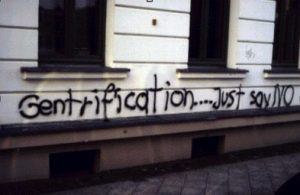(ThyBlackMan.com) We’ve all heard the term bantered about, but what does gentrification really mean? Gentrification was coined back in 1964 by Ruth Glass – a British sociologist – referring to changes in the housing market and structure in inner city London. Gentrification sometimes vilified as a way of displacing Black folk from their own neighborhoods. 12 percent of low-income neighborhoods are experiencing advanced or on going gentrification, and an additional nine percent experience displacement. (You know your neighborhood is being gentrified when you begin to see more dogs than children.) Currently, the most gentrified communities are located on the East and West coasts, or Texas.
According to Katy Kreitler, gentrification is racist and classist, and hurts marginalized people by disrupting their established communities. The process of development, by its very nature, is a cultural reality in which those with economic, political, and social power have more control over space. Colin Kinniburgh seems to agree, arguing that gentrification is about power, profit, racism, and violence on a larger scale. Historically, gentrification has gone by different names, but the results are always the same: the displacement and disruptions of local indigenous communities. 
Ron Daniels, of the Richmond Free Press explain, ” During the Civil rights and Black Power movements, the term ‘Negro Removal’ became synonymous with ‘urban renewal.’ This is where federal, local, and state highway and development projects often disconnect and destroy stable Black communities for the benefit of residents from the suburb. In the 1960s and 70s, Negro Removal moved Blacks out of cities for so-called “revitalization.” White people do not show up in desirable neighborhoods and offer Black people and others a good deal to move out of their communities. Dating back to the arrival of white people in North America, there has been an intentional effort to remove “others” desirable areas. However, gentrification is somewhat different.
Instead, gentrification is enforced through government actions such as zoning, permits, tax laws, and other mechanisms. City officials welcome the economic change because of the increased tax base and cosmetic improvements to downtown areas. In Austin, Texas, mid-century homes in East Austin, are being replaced by $700,000 duplexes. A Whole Foods will soon open next door to Chalmers Court – one of the nation’s oldest public housing projects. On a recent visit to the capital city of Texas, I knew something was amiss when I witnessed throngs of urban hippie types spilling onto the patio at Sam’s BBQ – a long time gathering spot for the city’s dwindling Black population. The owner turned down a $5 million buyout. Long time East Austin native Wilhelmina Delco says, “I’ve lived in East Austin for 60 years, I don’t recognize it anymore. As gentrification reshapes my neighborhood, I fear we’re losing something of real value to our city. Black families who grew up here, with kids, who are now comfortably middle-class, have to move out to afford a home and schools. Others moved to Pflugerville and North Austin.”
Also, Atlanta, Georgia, the unofficial Black Mecca, ranks ” fifth among U.S. cities experiencing the most gentrification with more than 46 percent of its census tract gentrifying. Median rents are, up 28 percent from 2000, compared to just nine percent nationally. According to the Brookings Institutions, Atlanta white population grew faster between 2000 and 2006: more than any other city in the U.S. However, Blacks have continued to move to the city steadily for the past 20 years – most settling in suburbs to the north.
Los Angeles zip code, 90014, (next to the infamous Skid Row) saw a 95 percent increase in median household income. However, the majority of its population lives below the poverty line.
At last count, up to as many as 59,000 people do not have permanent housing across Los Angeles county – up some 12 percent from last year. That being said, it appears LA county is looking into methods to help to decrease the local homeless population in meaningful ways. In January 2020, a new law will cap the amount of rent increases statewide. This could curb the number of people becoming homeless as the result of unaffordable rent hikes.
Facts About the 2019 Homeless Population in Los Angeles County:
- 9% are under age 18.
- 31% are female.
- 15% are in family units (often headed by a single mother}.
- 16% are physically disabled.
- 28% are chronically homeless.
- 15% of homeless population have substance abuse disorders.
- 25% of homeless population suffers from serious mental illness.
- 7% of homeless population were victims of domestic/intimate partner violence.
But what is driving the rich back into American cities? Peter Moskowitz breaks the process of gentrification down into four basic steps. First, investors seeking cheap rent move into disinvested neighborhoods, often populated by artsy types. Second, more middle class folk follow and real estate interest is peaked. Third, the new middle class resident begins to shift power dynamics of the neighborhood’s institutions. And finally, the original gentrifies can no longer afford to live in these areas any longer and get pushed out. This phenomenon repeats itself in almost every downtown city across America.
Decommodifying housing, according to David Madden and Peter Marcuse would help tremendiously. In Defense of housing they argue that enacting rent control laws and land off the speculative market using community land trust – “nonprofit, community based organizations designed to ensure community stewardship of land.” According to Moskowitz, grassroots organizations, internationally as well as nationwide, are fighting for more equitable terms for all. Outrages rents make everyone suffer. It’s important for folks to organize and fight against the constant (rent) increases.
Staff Writer; Gustavus Betts
One may connect with this brother on Facebook; G. Betts and Twitter; Gustavusb.

















Leave a Reply